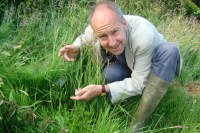Biodiversity call for organic farming

Dr Peter Dennis, IBERS
24 June 2014
A report published today (Tuesday 24 June) in the scientific journal Nature Communications states that targeted action for biodiversity is needed for organic agriculture as well as conventional farming systems.
An international team led by Agroscope in Switzerland including an Aberystwyth University research team led by IBERS scientist Dr Peter Dennis working on the BioBio project, investigated the contribution of organic farming to conserving farmland biodiversity.
The study investigated farms in ten European and two African regions with different production systems. In each region, twelve to twenty farms were selected randomly, half of them certified organic for at least five years. No constraints were set on the other farms.
The paper “Gains to species diversity in organically farmed fields are not propagated at the farm level” Schneider M.K. et al. (2014) is available online at http://bit.ly/1iBHVER.
The work started in 2010 with all results collated and completed in 2013 and the researchers were particularly interested in the farm scale, i.e. the question of whether organic farms harbour more species than their non-organic neighbours.
Dr Peter Dennis said; “More than organic farming is needed to sustain farmland biodiversity. “Surprisingly, we did not find a higher number of different habitats on organic farms than non-organic farms, on average over all twelve regions. However, it was clear-cut that the diversity of habitats is key to species diversity. “If these additional habitats are different to the rest of the farm, for example hedges in grassland farms or herbaceous strips in arable farms, they have a huge impact on the species richness of a farm. “We recommend that farmers increase the number of habitats on their farms, and we can discuss how that can be achieved with interested farmers.”
The major enterprise of farms investigated in the Wales case study was livestock production. All twenty farms in Wales (surveyed for habitats and plants; 16 surveyed for earthworms, spiders and bees) were situated in the upland margins, uplands or hill categories within the Less Favoured Area. Irrespective of organic or conventional management system, all the farms practiced low to moderate intensity of management, thus there was less distinction when nutrient inputs and mechanised operations were compared.
There were consistent gains to total species richness of recorded plant and animal groups in managed grassland on organic compared with conventionally managed farms. There was no significant gain in species of any of the indicator groups at the farm level for organic compared with conventionally managed farms.
One explanation is the very high habitat richness across both farm categories in Wales, average 12-15 different semi-natural habitats, and one of three case study regions with the highest values (others are Gascony, France and Bavaria, Germany). These semi-natural habitats contribute the bulk of the species on a particular farm.
The Welsh farms in general supported high numbers of species of spiders and there was one farm which had the record highest number of different spider species of all 205 farms across Europe and north and east Africa!



